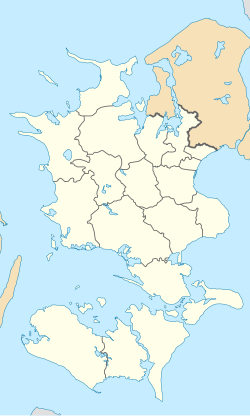
Back Kalundborg AST Калундборг Bulgarian Kalundborg Catalan Kalundborg (kapital sa munisipyo sa Danismark) CEB Kalundborg Czech Kalundborg Danish Kalundborg German Kalundborg Spanish Kalundborg Basque کالوندبورگ Persian
You can help expand this article with text translated from the corresponding article in Danish. (January 2023) Click [show] for important translation instructions.
|
Kalundborg | |
|---|---|
Town | |
 Seaport town of Kalundborg, Denmark. | |
| Coordinates: 55°40′53″N 11°5′6″E / 55.68139°N 11.08500°E | |
| Country | Denmark |
| Region | Zealand (Sjælland) |
| Municipality | Kalundborg |
| Area | |
| • Urban | 16.9 km2 (6.5 sq mi) |
| Population (2024)[1] | |
| • Urban | 16,558 |
| • Urban density | 980/km2 (2,500/sq mi) |
| • Gender[2] | 8,101 males and 8,457 females |
| Demonym | Kalundborgenser |
| Time zone | UTC+1 (CET) |
| • Summer (DST) | UTC+2 (CEST) |
| Postal code | 4400 |
Kalundborg (Danish: [kʰælɔnˈpɒˀ]) is a Danish city with a population of 16,558 (1 January 2024),[1] the main town of the municipality of the same name and the site of its municipal council. It is situated on the northwestern coast of the largest Danish island, Zealand (or Sjælland in Danish), on the opposite, eastern side of which lies the capital Copenhagen, 110 km (68 mi) away.
Kalundborg is famous as the location of a large broadcasting facility, the Kalundborg Transmitter. The city was also home to the largest coal-fired power station in Denmark, the Asnæs Power Station, which started its transition to biomass in 2017.[3]
Kalundborg is mainly a trading and industrial town, but is also well known for its five-spired Church of Our Lady, which is closely associated with King Valdemar I and the Archbishop Absalon. The church itself is said to have been built by Absalon's brother, Esbern Snare.[citation needed]
Kalundborg is also the traditional seat of the aristocratic Lerche family. Their stately home, Lerchenborg, the best example of rococo architecture in Denmark, can be seen in the town's outskirts.
Ferries connect Kalundborg westward to the island of Samsø.
- ^ a b BY3: population 1. January by urban areas, area and population density The Mobile Statbank from Statistics Denmark
- ^ BY1: Population 1. January by urban areas, age and sex The Mobile Statbank from Statistics Denmark
- ^ Voegele, Erin (2 November 2017). "Biomass conversion begins at Asnæs Power Station". Biomass Magazine. BBI International. Retrieved 21 January 2022.


